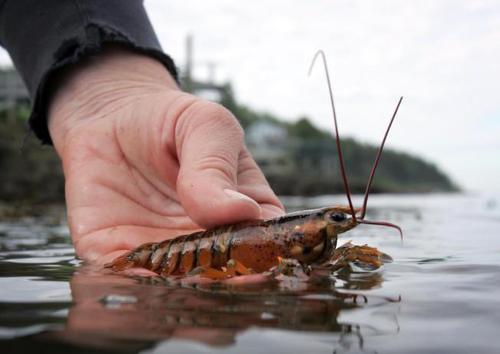Enjoy the Plentiful Lobster Rolls While They Last

“Maine baby lobster decline could mean end to record catches as lobstermen, scientists worry” said an AP report this week. This AP file photo (credit: Robert F. Bukaty) shows one of the thousands of baby lobsters counted every year along the Maine coast by dedicated teams of wetsuit-clad marine biologists, including the scientists I write about in The Secret Life of Lobsters. After decades of seeing the lobster population in Maine increase, the scientists think we might be looking at the start of a downswing. What are the implications for our dining habits? Read on, you’ll recognize some of the scientists quoted in the AP article if you’ve read The Secret Life of Lobsters:
The downward trend has lobstermen, retailers, state officials, and ocean scientists concerned that the impact could soon be felt on dinner tables nationwide. Maine lobsters were 85 percent of the nation’s lobster catch in 2012.
Warmer ocean temperatures, pollution, atmospheric conditions and changes in predation and availability of food could all be to blame, say scientists, state officials and industry leaders. Lobsters are very sensitive to even subtle changes in temperature, scientists say.
Maine Department of Marine Resources officials say the decline does not appear to be the product of overfishing as some environmental groups contend.
The last three years have brought record hauls to Maine’s lobster industry, more than 350 million pounds — by far the most for any three-year period according to state data that go back to 1880. The value of the catch has topped $1 billion for the first time.
Larger catches generally follow high levels years earlier of baby lobster settlement — the process in which young lobsters reach the ocean floor and grow. The boom in lobster catches in recent years follows a trend of heavy lobster settlement in the mid-2000s, university scientists say.
But that pace might not be sustainable, says Carl Wilson, the state’s lobster biologist.